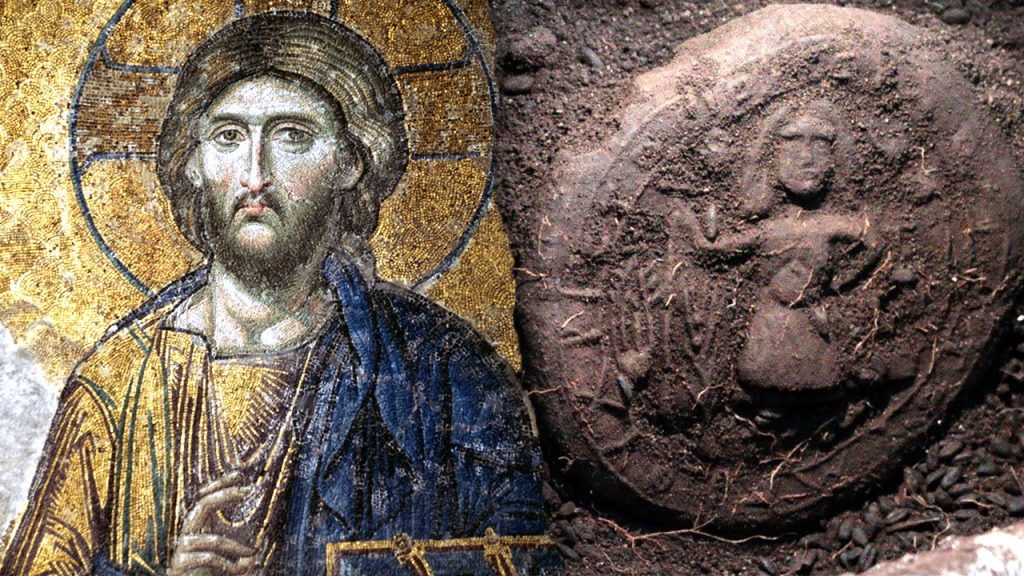Ancient Bread Reveals Early Christian Artistry and Faith
In a remarkable archaeological discovery that bridges ancient faith practices with modern understanding, a 1,200-year-old loaf of bread bearing the image of Jesus Christ has been unearthed in south-central Turkey. The Karaman Governorship announced the finding on October 8, showcasing what experts believe is an exceptionally preserved example of early Christian communion bread. Dating back to the 7th or 8th centuries AD, the bread was discovered among five carbonized loaves at the Topraktepe archaeological site, once known as the ancient city of Eirenopolis. This discovery offers us a rare glimpse into the spiritual practices of early Christians, highlighting how faith was woven into the fabric of daily life. The bread’s preservation through carbonization is described as exceptional, making these loaves among the best-preserved examples ever found in Anatolia. What makes this discovery particularly touching is the personal inscription: “With gratitude to the Blessed Jesus” – a heartfelt expression of devotion that resonates across twelve centuries.
Unlike the commonly depicted Christ Pantocrator iconography (where Jesus is shown raising his right hand in blessing, a standard in Byzantine and Eastern Orthodox art), this bread portrays Jesus as a sower or farmer. This representation reflects the deep connection early Christians felt between their faith and the agricultural rhythms that sustained their communities. By depicting Christ in this manner, the bread’s creators emphasized the symbolic importance of fertility and labor in religious thought of the period. This portrayal reminds us that early Christianity was deeply intertwined with the realities of daily survival and the miracle of harvest. Other loaves from the same collection feature different spiritual symbols, including what appears to be a Maltese Cross, suggesting these were not merely food items but sacred objects intended for ritual use in early Christian ceremonies.
Specialists believe these carbonized loaves represent Eucharist bread used in early Christian communion rituals. The Eucharist, or Holy Communion, has been central to Christian worship since the religion’s beginnings, commemorating Jesus’s Last Supper with his disciples. What makes this finding so extraordinary is how it physically connects us to the tactile experience of ancient Christian worship. Unlike stone carvings or metal artifacts that commonly survive the centuries, bread—being organic and perishable—rarely endures. That these loaves survived provides an intimate connection to the hands that formed them, the ovens that baked them, and the congregations that broke them in sacred remembrance. The bread’s survival through carbonization speaks to exceptional preservation conditions at the site, offering archaeologists a rare opportunity to study the material culture of early Christian ritual practice.
This discovery joins a growing collection of significant early Christian findings throughout the Anatolia-Caucasus region in recent years. In 2024, archaeologists announced the uncovering of one of the world’s oldest Christian churches in Armenia, dating to the 4th century—the same period when Armenia officially adopted Christianity as its state religion. This Artaxata church represents a pivotal moment in Christian history, as Armenia became the first nation to adopt Christianity as its official faith. Similarly, in Turkey’s Antalya province, excavations at Olympus (an ancient Lycian port city) revealed a 5th-century Christian church bearing the inscription: “Only those on the righteous path may enter here.” These discoveries collectively illuminate the rapid spread and cultural integration of Christianity throughout the region during the religion’s formative centuries.
The bread’s discovery provides valuable insights into how early Christians incorporated their faith into everyday objects and practices. Before widespread literacy and the availability of religious texts, visual representations on common items like bread served as powerful reminders of faith and doctrine. The deliberate imprinting of Christ’s image onto communion bread transformed a basic necessity into a sacred object, blurring the line between sustenance for the body and nourishment for the soul. This practice illustrates how early Christians experienced their faith in tangible, multisensory ways—not just hearing scripture or participating in prayer, but literally consuming sacred imagery as part of their spiritual practice. The bread also demonstrates the technological capabilities of these early bakers, who developed techniques to create detailed impressions that would remain visible even after baking.
The continued discovery of early Christian artifacts across Turkey and Armenia highlights the region’s crucial role in Christianity’s development and spread. These lands, situated at the crossroads between Europe, Asia, and the Middle East, served as vital corridors through which Christianity traveled and transformed from a small Jewish sect into a world religion. Each archaeological finding adds another piece to our understanding of how diverse communities interpreted and expressed their newfound faith. The bread loaves of Topraktepe, with their unique imagery and inscriptions, represent not just religious artifacts but deeply human expressions of gratitude, hope, and devotion. Across twelve centuries, these humble loaves speak to us about the people who created them—their beliefs, their artistic sensibilities, and their desire to connect with the divine through the simplest elements of daily life. In their carbonized state, they have become timeless messengers of faith, bridging the gap between ancient worship practices and our modern understanding of early Christianity.


